Enhanced field emission performance of gold nanoparticle decorated Bi2S3 nanoflowers
- PMID: 39619387
- PMCID: PMC11603640
- DOI: 10.1039/d4na00539b
Enhanced field emission performance of gold nanoparticle decorated Bi2S3 nanoflowers
Abstract
Au nanoparticles (NPs) are decorated on hydrothermally synthesized Bi2S3 nanorods (NRs) to enhance the field electron emission (FEE) performance as compared to bare Bi2S3 nanorods, resulting in reduction in turn-on field from 3.7 to 2.7 V μm-1 (at the current density of 1.0 μA cm-2) with significant increment in maximum emission current density from 138 to 604.8 μA cm-2 (at a field of 7.8 V μm-1) respectively. FESEM/TEM reveals that Bi2S3 nanoflowers are assembled from Bi2S3 NRs of a typical diameter of 120 ± 10 nm, and Au NPs of diameter about 5-10 nm are uniformly decorated onto the surface of NRs to form an Au/Bi2S3 composite. XRD analysis suggests that the as-synthesized product consists of orthorhombic Bi2S3 NRs decorated with face-centered cubic Au NPs. The XPS spectrum shows the elemental mapping of the as-synthesized Au/Bi2S3. Improvement in field emission properties is mainly attributed to a reduction in work function and increasing emitting sites due to Au NP decoration.
This journal is © The Royal Society of Chemistry.
Conflict of interest statement
The authors declare no conflicts of interest.
Figures






References
-
- Choi W. Chung D. Kang J. Kim H. Jin Y. Han I. Lee Y. Jung J. Lee N. Park G. Fully sealed, high-brightness carbon-nanotube field-emission display. Appl. Phys. Lett. 1999;75(20):3129–3131. doi: 10.1063/1.125253. - DOI
-
- Baker F. Osborn A. Williams J. Field emission from carbon fibres: a new electron source. Nature. 1972;239(5367):96. doi: 10.1038/239096a0. - DOI
-
- Zhang H. Tang J. Zhang Q. Zhao G. Yang G. Zhang J. Zhou O. Qin L. C. Field emission of electrons from single LaB6 nanowires. Adv. Mater. 2006;18(1):87–91. doi: 10.1002/adma.200500508. - DOI
LinkOut - more resources
Full Text Sources
Miscellaneous

